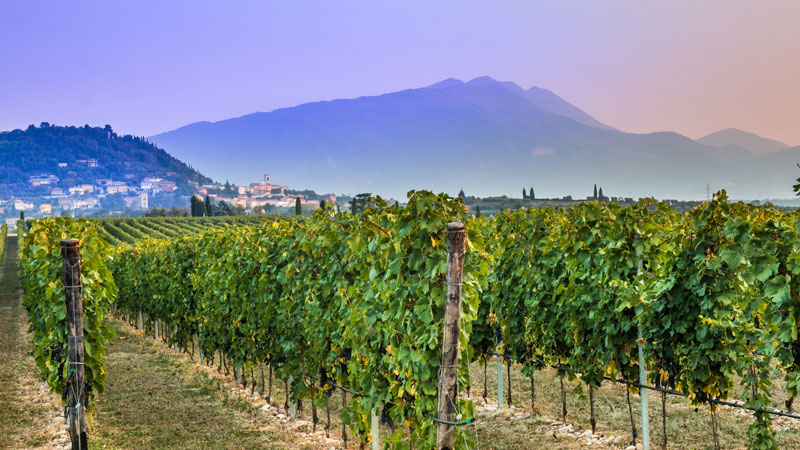Rosé is arguably the wine industry’s biggest success story of the 21st century. Winemakers worldwide are producing more pink juice than ever before, and those of us in the U.S. have more to choose from than any other time in our history.
As with any other product category, from brick oven pizza to alternative rock, success inspires imitation. To the chagrin of those of us who love wine, there’s been a rush to market by an endless line of mediocre imitators looking to profit off the pale-pink, bone-dry Provencal style.
More optimistically, however, this trend has also led a number of winemaking regions to increase their focus on rosé. For consumers, looking beyond the obvious Provencal producers can pay dividends.
This is especially evident in Italy’s Bardolino region, near Lake Garda’s eastern shores. Bardolino’s pink wine, Chiaretto (pronounced key-a-ret-toh), is largely unknown in the U.S. but perfectly suited to our palates.
These wines are about as pale as rosé gets — chiaro is the Italian word for clear — and feature intensely floral aromas with citrus notes, followed by a steely, fiercely acidic palate. Each bottle has a salty, savory quality evocative of the lake shore. Applying the term “minerality” has become a wine writer cliché, but Chiaretto earns this descriptor — as does Bardolino Rosso, the region’s red wine.
The recent rise of Chiaretto can be attributed to the tireless work of Angelo Peretti, director of the Bardolino wine consortium. Peretti, along with a group of producers following his vision, is creating what is now known locally as “the rosé revolution.”
Chiaretto production in Bardolino dates back to the late 1800s, but it was traditionally seen as a cheap, simple, summertime beverage. “For a long time Chiaretto was dark in color and could not age at all,” Peretti says. “Winemakers didn’t respect the native grapes. By August or September it would collapse, become oxidized.”
In 2008, Peretti starting thinking about Corvina. Famously part of Italy’s legendary Amarone della Valpolicella wines, the grape also happens to be Bardolino’s main variety.
“I thought the right way to produce rosé at Lake Garda was to respect the territory, including the saltiness of the regional soils, as well as the native grape and its naturally lighter color,” he says.
Peretti began teaching local producers French rosé techniques, such as using soft pressure on the grapes, keeping very low temperatures during harvest — which requires picking early in the morning — and fermentation that preserves Corvina’s light color and citrusy flavors.
In 2014, the revolution had a breakthrough. “We had a dramatic vintage that year,” Peretti says. “It was very rainy, and everybody thought it would be impossible to make good wine. So I asked the producers to try the methods we’d been talking about, because they had nothing to lose. And it was a big success. They learned not only that they could do it this way, but that it was easy, and that the market response was great.”

Now, Peretti aims to make Bardolino’s rosé revolution permanent. He is encouraging producers to embrace a philosophical and cultural shift. Gone are the days when rosé was just a byproduct of more important reds.
“Rosé is not a method,” Peretti says. “To make great rosé, we need to respect the terroir, the identity and characteristics of each area.” This includes selecting specific sites and training the vines differently from those intended for red production.
“For Chiaretto, we want citrus notes, but for Bardolino [rosso] we prefer that ripe cherry fruit,” Peretti says. “Chiaretto grapes must be harvested earlier to maintain freshness, and we must grow the vines to achieve the correct phenolic ripeness and to avoid green notes. We have to split our vineyards between rosé and red wine, in order to produce the best quality in both.”
This is particularly challenging in Italy, where rosé is less popular than in France and the U.S. Italy is the world’s second-largest exporter of pink wine, but Italians rank sixth in rosé consumption. Category growth has remained elusive. Much of what Italians do consume falls in the cheap, bulk category made for mindless summertime quaffing.
Historically, demand for Chiaretto’s previous iteration (short shelf life, dark color) came only from northern Italy and southern Germany. But increased quality and marketing, especially via social media, is beginning to open markets like the U.S., Canada, and Scandinavia. It’s even growing in France, which Peretti compares to selling ice cream at the North Pole.
Though he’s not eager to over-expand, Peretti sees continued opportunity for a steady, consistent growth. Chiaretto production increased 12 percent in 2017.
“Nowadays we sell Chiaretto all year, in comparison to only March through August previously,” he says. “One of the best months is November. It’s incredible.
“By looking to our soils, our land, and our grapes,” he continues, “we’ve found our identity. Now our goal is to present that to new markets. Not to produce wines for a particular market, but instead to find the markets that match our identity.”
Chiaretto is still very much a niche product; production is about 5 percent of the pink wines coming out of Provence. The market for Chiaretto is those more interested in authentic quality products than T-shirt or hashtag slogans. That’s what the Bardolino producers are counting on, at least.
In April 2018, Peretti began his “next revolution.” A new agreement connects the five Italian regions that have historically produced rosé from indigenous grapes, including Chiaretto di Bardolino, of course; Valtenesi Chiaretto (made on the Lombardy side of Garda, using Groppello); Cerasuolo d’Abruzzo (made from Montepulciano); and rosato from two parts of Puglia: Salice Salentino (Negroamaro) and Castello del Monte (Bombino Nero).
“We don’t see ourselves as competitors, rather as complementary,” Peretti says in a rare show of amity among Old World wine regions. “So we’ve decided to try to explain, to both Italians and the world, that Italy has a long history in the production of rosé and that each region has unique characteristics to offer.”
“We want to help people understand that historical rosé does not just come from France,” he says. “We are proudly sure of our quality and believe we can offer strong competition to the popular French rosés.”
Three Bottles of Chiaretto to Try
Le Morette Bardolino Chiaretto Classico 2016: A perfect example of the style, this pale pink wine has fresh citrus notes and a stony finish.
Vigneti Villabella Bardolino Chiaretto Heaven Scent 2016: Fresh fruit, with floral notes and integrated acidity.
Marchesini Chiaretto Rosé 2016: Dry and fruit-forward, this rosé has notes of stone fruit on the finish.
